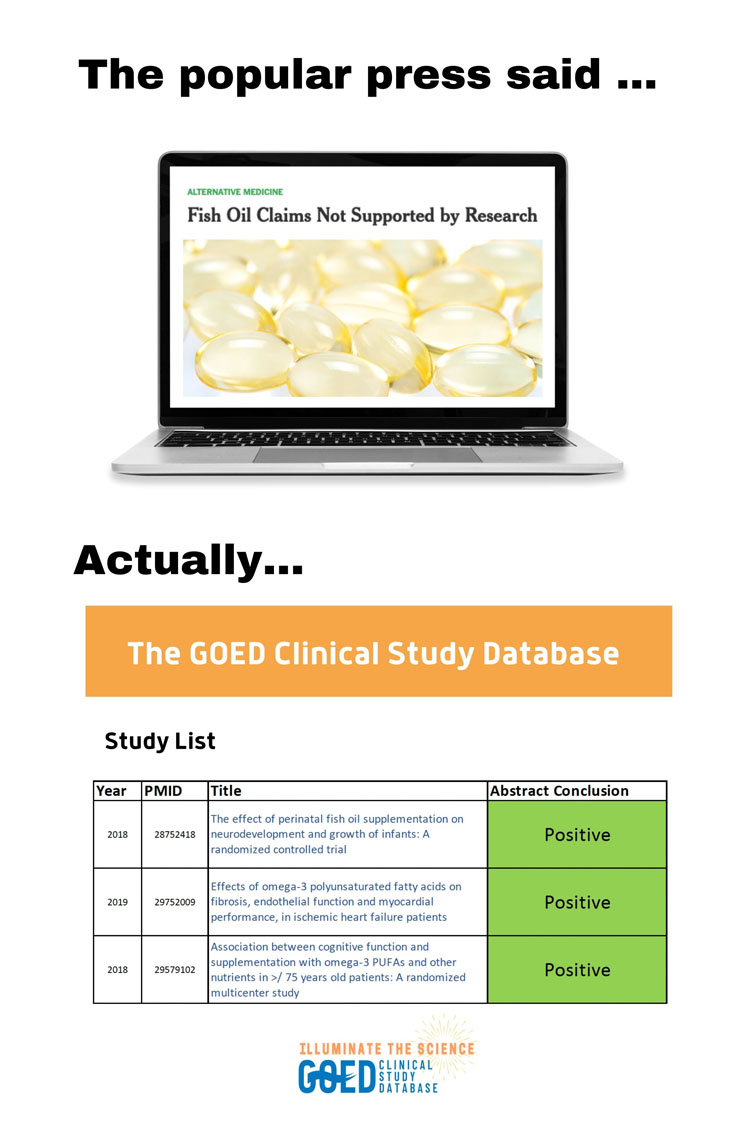A brand-new tool to help industry understand the full body of evidence that supports the health effects of EPA and DHA omega-3s was recently launched by GOED, the Global Organization for EPA and DHA Omega-3s.
The Clinical Study Database (CSD) can provide summaries of information and enhance knowledge translation, which, in turn, can be used to educate consumers and help healthcare practitioners in their conversations with clients or patients.
For industry, it can help companies with product development, marketing claim substantiation and future scientific research. The scope and possibilities of this tool are extensive, and GOED is still learning how subscribers are engaging with this tool for their work.
Why create a clinical study database (CSD)?
One of the original drivers to create the CSD was the proliferation of misleading and negative consumer media articles about EPA and DHA. To provide supporting evidence to rebut the inaccuracies in these articles took days, which was much too long for the current super-fast news cycle. With the CSD, subscribers can now look at the totality of evidence with the click of a button.
The CSD can also be used to understand health outcomes, allowing for more tailored or specialised recommendations in the future. For example, there may be 20 human interventional studies looking at joint aches and pain, each with age groups and varying levels of health. Comparing these studies might reveal important population-specific recommendations to improve symptoms.
Additionally, although we are lucky to have more than 40,000 scientific papers on EPA and DHA, this vast amount of research makes understanding the science a challenge. The CSD, which has been many years in the making, curates all these published papers in a comprehensive, searchable interface, with details for human interventional studies including demographics, dosage, study design, etc.
The CSD works like a sophisticated PubMed; but, unlike PubMed, it also includes data on every outcome in each study, not just what’s covered in the abstract.

Outcomes of the CSD are endless
What if generating an idea for the next product or new research grant could be achieved in 6 minutes instead of 6 months? Time is precious and using the CSD can move science from cyberspace to your laptop in a matter of seconds. In addition to saving time, the CSD can also be used to
- respond to and comment on media articles
- prepare white papers and opinion articles
- perform systematic reviews and meta-analyses
- identify gaps in research
- substantiate health and structure/function claims
- provide direction in product development and marketing.
Companies can use the database to understand the specific attributes of various study populations to make a more specific recommendation for dose or type of omega-3. For example, there may be 70 human interventional studies on people with dementia.
Using the dosage filter, the database would show that 10 studies reported a dose of 250–500 mg of EPA+DHA, 15 reported a dose of 500–1000 mg of EPA+DHA and 40 reported a dose of 1000 mg of EPA+DHA or greater. Comparing the various clinical markers in these studies, the user might find dose-dependent differences in symptoms of dementia.
The CSD also allows users to examine other interventional components. There are many factors influencing our health, including genetics, age, diet, exercise habits, etc. What if there is an additive effect for health outcomes when EPA and DHA supplementation is paired with another supplement (such as vitamin D) or a lifestyle intervention (yoga or sudoku puzzles)? The possibilities for discovery are endless!
To cite a specific example, GOED has been working on a project utilising the CSD to look at the impact of EPA and DHA omega-3 on cognitive health. This research was led by Dr Mélanie Plourde at the Université de Sherbrooke in Quebec, Canada, who subsequently used the CSD to visualise the scientific information and generate data for a systematic review.
To those in the field, it will come as no surprise that comparing these studies was very difficult, as there is a huge amount of heterogeneity in the research to date. To get a better understanding of the effects of EPA and DHA, population characteristics (age, health status, genetics) and cognitive tests (diagnostics, assessment, clinical versus functional) will need to be carefully considered in future research.
Despite there being hundreds of articles in the field of cognitive health, only a handful at a time can truly be compared because of the huge array of cognitive tests used, which are not directly comparable with each other.
The CSD is the first database of its kind. Industry and researchers will be able to jump in and use this tool as the research on omega-3s continues to evolve and develop. Importantly, the CSD can also extend beyond omega-3s.
Other industries or trade associations could use this novel structure and unique framework of the CSD for their own ingredient or nutrient of interest. For example, a database focused on calcium (or turmeric or probiotics, etc.) may help to uncover and substantiate recommendations for intake or benefits for certain population groups with adequate or increased consumption.
